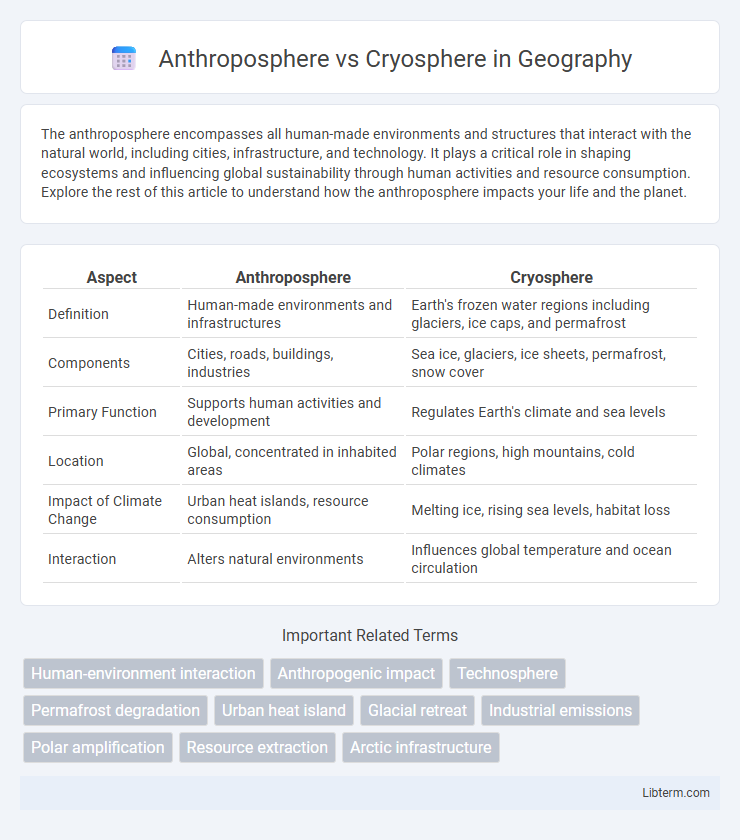The anthroposphere encompasses all human-made environments and structures that interact with the natural world, including cities, infrastructure, and technology. It plays a critical role in shaping ecosystems and influencing global sustainability through human activities and resource consumption. Explore the rest of this article to understand how the anthroposphere impacts your life and the planet.
Table of Comparison
| Aspect | Anthroposphere | Cryosphere |
|---|---|---|
| Definition | Human-made environments and infrastructures | Earth's frozen water regions including glaciers, ice caps, and permafrost |
| Components | Cities, roads, buildings, industries | Sea ice, glaciers, ice sheets, permafrost, snow cover |
| Primary Function | Supports human activities and development | Regulates Earth's climate and sea levels |
| Location | Global, concentrated in inhabited areas | Polar regions, high mountains, cold climates |
| Impact of Climate Change | Urban heat islands, resource consumption | Melting ice, rising sea levels, habitat loss |
| Interaction | Alters natural environments | Influences global temperature and ocean circulation |
Introduction to the Anthroposphere and Cryosphere
The anthroposphere encompasses all human-made environments and activities, including urban areas, infrastructure, and industrial processes that significantly alter natural ecosystems. The cryosphere consists of Earth's frozen water components, such as glaciers, ice caps, sea ice, and permafrost, playing a crucial role in global climate regulation and sea-level balance. Interactions between the anthroposphere and cryosphere are critical in understanding climate change impacts, as human activities accelerate ice melt and disrupt natural cryospheric processes.
Defining Key Characteristics
The anthroposphere encompasses all human-made structures, technologies, and activities that alter Earth's environment, including urban areas, infrastructure, and industrial systems, highlighting human influence on the planet. In contrast, the cryosphere consists of Earth's frozen water components, such as glaciers, sea ice, permafrost, and snow cover, playing a critical role in climate regulation and sea-level stability. Understanding these distinct spheres illuminates the dynamic interaction between human development and the planet's natural cold regions.
Origins and Components
The anthroposphere originates from human activities and technological development, comprising built environments, infrastructure, and socio-economic systems. The cryosphere consists of Earth's frozen water components, including glaciers, ice caps, sea ice, and permafrost, formed through natural climatic processes over millennia. Both spheres interact dynamically, influencing global climate patterns and ecological balance.
Human Impact on the Cryosphere
Human activities within the anthroposphere have accelerated the degradation of the cryosphere, leading to accelerated melting of polar ice caps and glaciers. Industrial emissions and deforestation contribute to global warming, which directly elevates temperatures in polar regions, causing permafrost thaw and ice shelf destabilization. The resultant loss of ice mass and altered freshwater cycles disrupt ecosystems and exacerbate sea-level rise, impacting both natural habitats and human communities.
The Role of the Anthroposphere in Climate Change
The anthroposphere, encompassing all human-made environments and activities, plays a critical role in climate change by contributing significant greenhouse gas emissions through fossil fuel combustion, deforestation, and industrial processes. These anthropogenic emissions disrupt the cryosphere by accelerating ice melt and permafrost thaw, which in turn amplify global warming via feedback loops such as reduced albedo and methane release. Effective mitigation strategies targeting the anthroposphere's carbon footprint are essential to preserving cryospheric stability and slowing climate change impacts.
Interactions Between the Anthroposphere and Cryosphere
The interactions between the anthroposphere and cryosphere significantly influence global climate patterns and human activities. Human-induced greenhouse gas emissions accelerate glacial melting and permafrost thaw, impacting freshwater availability and sea level rise. Conversely, changes in the cryosphere alter infrastructure stability and pose challenges for communities relying on ice-dependent ecosystems.
Environmental Consequences of Their Interplay
The interplay between the anthroposphere, encompassing human activities and infrastructures, and the cryosphere, consisting of Earth's frozen regions, drives significant environmental consequences such as accelerated ice melt and rising sea levels. Human-induced greenhouse gas emissions intensify cryospheric warming, disrupting polar ecosystems and amplifying global climate change effects. This interaction further leads to altered weather patterns, habitat loss, and increased vulnerability of coastal and Arctic communities.
Case Studies: Melting Ice and Urban Expansion
The cryosphere experiences accelerated melting due to rising global temperatures, exemplified by case studies in the Arctic and Antarctic regions where ice mass loss contributes to sea level rise. Urban expansion within the anthroposphere exacerbates this effect by increasing greenhouse gas emissions and land surface alterations, as seen in cities like New York and Beijing, which influence local microclimates and global weather patterns. Integrated research highlights the interdependency between anthropogenic activities and cryospheric changes, underscoring the urgency for sustainable urban planning to mitigate ice melt and its global impacts.
Mitigation Strategies and Adaptation
Mitigation strategies in the anthroposphere focus on reducing greenhouse gas emissions through renewable energy adoption, energy efficiency improvements, and sustainable urban planning to slow cryosphere melting. Adaptation efforts include enhancing infrastructure resilience in polar and glacial regions, implementing early warning systems for ice-related hazards, and supporting community relocation plans due to changing cryosphere landscapes. Integrating scientific monitoring with indigenous knowledge further strengthens both mitigation and adaptation frameworks addressing cryosphere vulnerability.
Future Outlook for Earth’s Spheres
The future outlook for the Anthroposphere and Cryosphere highlights contrasting dynamics where human activities increasingly drive climatic changes, accelerating the melting of polar ice caps and glaciers within the Cryosphere. This loss of ice mass alters sea levels and global temperature regulation, impacting Biodiversity, ocean currents, and weather patterns globally. Sustainable interventions in the Anthroposphere, including reduced carbon emissions and innovative climate policies, are critical to mitigating Cryospheric degradation and maintaining Earth's systemic balance.
Anthroposphere Infographic

 libterm.com
libterm.com